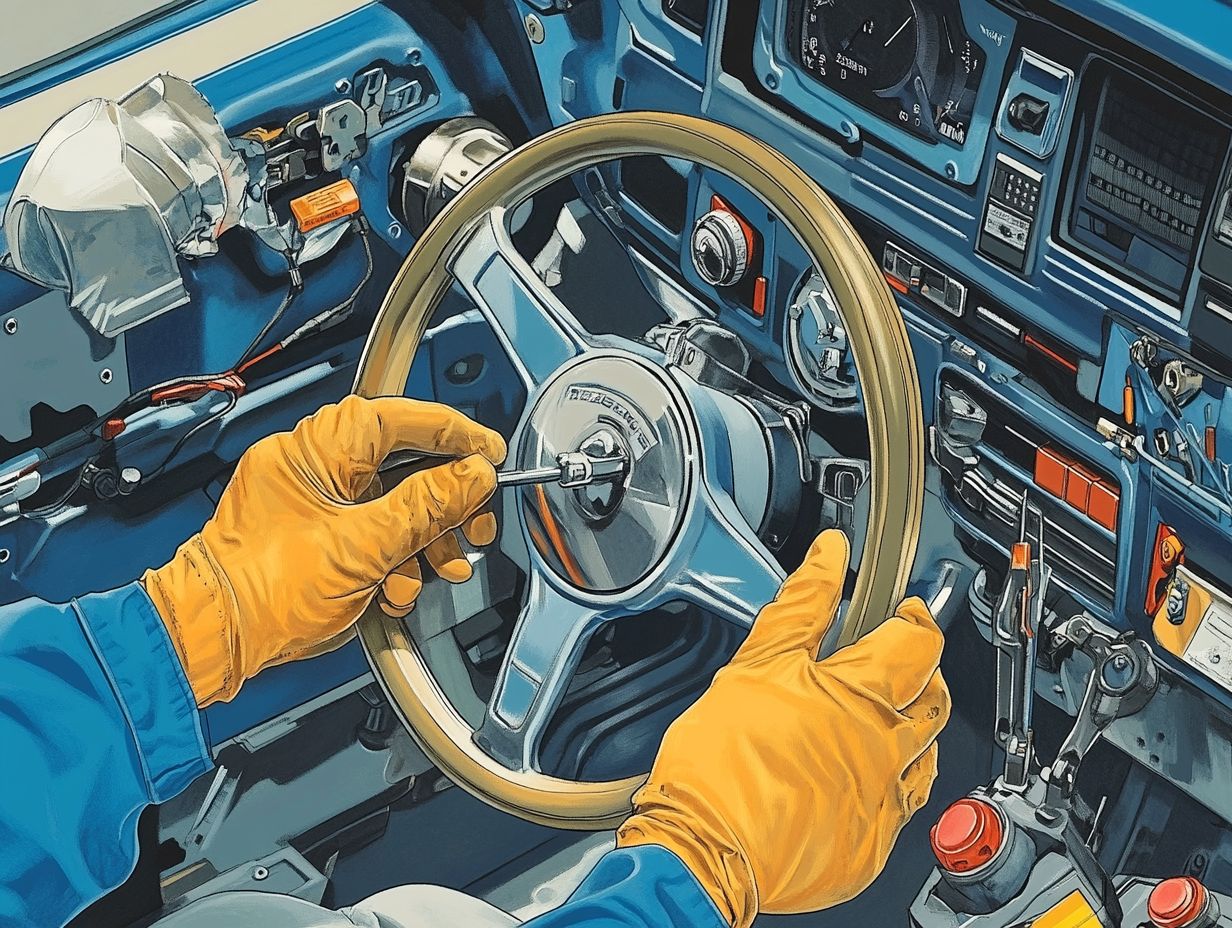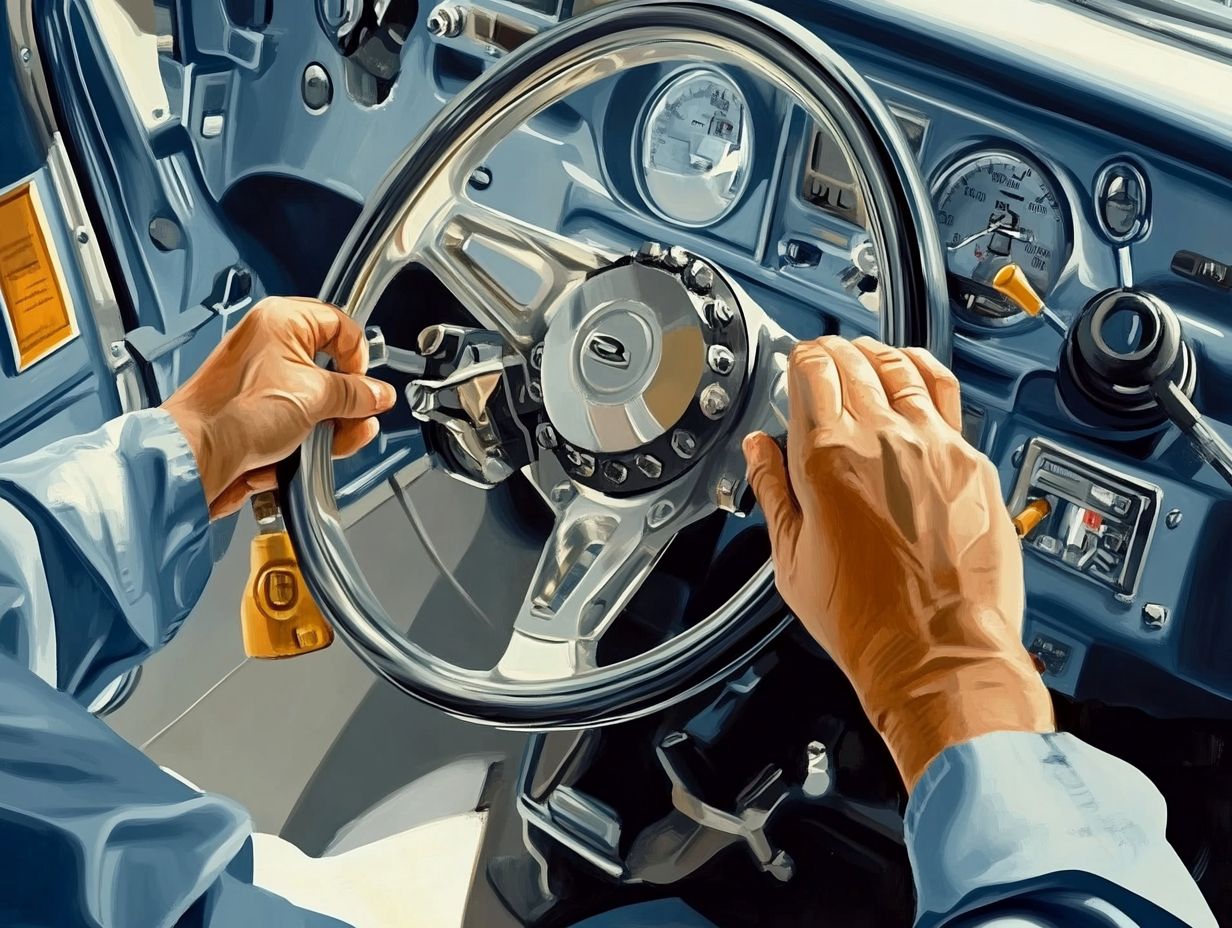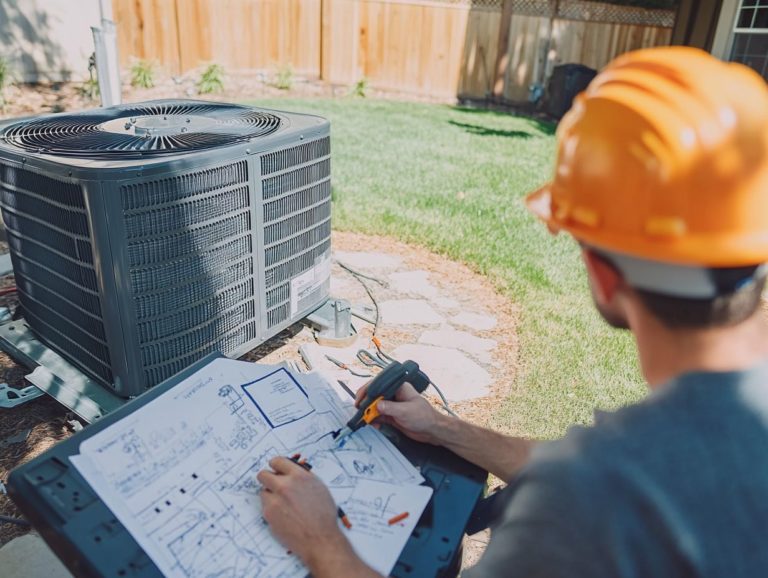Understanding the Most Common Steering Issues
Steering issues can make you feel vulnerable on the road. It’s essential to recognize and address them without delay.
This guide will break down various types of steering problems, from simple steering wheel quirks to more complex system malfunctions. You’ll discover how to identify common signs of trouble, diagnose root causes, and explore effective solutions for repairs.
You ll also find maintenance tips to help prevent these issues from cropping up in the first place.
Stay safe and informed dive in to enhance your understanding of steering!
Contents
- Key Takeaways:
- What Causes Steering Issues?
- Types of Steering Issues
- Signs of Steering Issues
- How to Diagnose Steering Issues
- Fixing Steering Issues
- Preventing Steering Issues
- Frequently Asked Questions
- What are the most common steering issues that car owners face?
- What causes difficulty in steering?
- How does steering wheel vibration occur?
- Why is uneven tire wear a common steering issue?
- Does steering wheel misalignment affect overall steering performance?
- How can I prevent or address these common steering issues?
Key Takeaways:

- Steering issues may occur due to various factors such as wear and tear, lack of maintenance, and improper alignment.
- Some common signs of steering issues include difficulty turning, uneven tire wear, and strange noises while steering.
- To diagnose steering issues, carefully observe and test the steering system, and seek professional help if needed.
What Causes Steering Issues?
Steering issues can arise from various factors that influence the overall performance of a vehicle’s steering system. Common culprits include low power steering fluid, defective parts, and worn components.
If these problems go unaddressed, they may put you and your vehicle at risk. Understanding these causes is key to keeping your car safe, ensuring optimal responsiveness, and preventing costly repairs in the future.
Types of Steering Issues
Steering issues can reveal themselves in various forms, each presenting distinct challenges. You might encounter problems with the steering wheel, feeling vibrations or stiffness that disrupts your drive.
Alternatively, you may face issues within the steering system itself, like poor alignment or lack of responsiveness. Understanding these different types of steering problems is crucial for pinpointing the necessary repairs. Ultimately, this ensures you enjoy a safe and smooth driving experience.
Problems with Steering Wheel
Issues with your steering wheel often point to deeper problems that can compromise vehicle handling and safety. Symptoms may include steering vibrations, difficulties turning, or an unresponsive wheel, all of which can make driving hazardous.
You may notice that your steering wheel feels either loose or stiff. This hints at potential defects in components such as the power steering system, tie rods, or even the steering rack. Address these concerns right away. Delaying can lead to serious challenges, including loss of control while navigating turns or during sudden maneuvers.
Particularly concerning are steering vibrations, which can signal imbalances or wear in the tires. This not only complicates driving but also jeopardizes overall vehicle stability. Regular maintenance checks can quickly spot these issues before they turn dangerous!
Issues with Steering System
Issues with the steering system can greatly affect your vehicle’s control and safety. It s essential to recognize and address these concerns promptly. Common problems include low power steering fluid, defective parts, or failures within the hydraulic steering system (a system that uses fluid to help you steer).
When the steering system isn t functioning properly, you may find it challenging to maneuver your vehicle. Low power steering fluid often results from leaks or evaporation, leading to increased strain when turning the wheel, accompanied by noticeable whining or groaning sounds. Defective components, like faulty tie rods or worn-out steering racks, can lead to imprecise handling, resulting in unpredictable vehicle behavior. A failing hydraulic steering system might make the steering feel excessively loose or too stiff, presenting significant risks during critical driving situations.
Regular maintenance and prompt repairs not only enhance your driving experience but also elevate the overall safety for everyone on the road.
Check your steering today and drive with confidence!
Signs of Steering Issues

Recognizing the early signs of steering issues is essential for maintaining your vehicle’s safety and preventing potential accidents. Look out for common indicators such as unusual noises from the steering system, difficulty turning the steering wheel, or any changes in responsiveness.
Acting quickly on these signs can boost your safety and your vehicle s performance!
Common Symptoms to Look Out For
Common symptoms of steering issues serve as early warning signals. Watch for steering vibrations, unusual noises, difficulty turning, or low power steering fluid levels.
Recognizing these indicators is crucial, not just for your comfort while driving, but also for ensuring the overall safety of your vehicle. For instance, vibrations in the steering wheel could indicate misaligned wheels or worn-out components. Unusual noises may signal loose parts or a failing pump. Difficulty turning is a red flag for issues with the power steering system, which could worsen if ignored.
Low power steering fluid can seriously compromise the system’s effectiveness, impacting your control over the vehicle. By promoting awareness of these symptoms through proactive maintenance, you can significantly reduce the risk of steering failures and enhance your driving safety.
How to Diagnose Steering Issues
Diagnosing steering issues requires a methodical approach to uncover the root causes affecting the steering system. Start by assessing the power steering fluid levels and inspecting the steering wheel and its parts for any visible defects. Don t hesitate to consult a qualified mechanic if needed.
Familiarizing yourself with the symptoms and indicators can enhance your ability to diagnose and repair effectively.
Steps to Identify the Problem
Identifying the problem in your steering system involves a series of methodical steps. Begin by checking the steering fluid levels and inspecting the steering components for wear or damage. Take your vehicle for a test drive to feel for any irregularities.
If the problem seems complex, consulting a mechanic for a thorough inspection might be necessary. Once you ve confirmed the fluid levels, assess the power steering pump and hoses for leaks. A drop in fluid can lead to compromised handling.
Next, examine the tie rods, bushings, and ball joints to ensure they are in good condition. Wear in these parts can create that annoying steering play.
Conduct a turn test to reveal any unusual noises. Also, perform alignment checks to ensure your vehicle tracks straight. Cumulatively, these evaluations will provide insights into whether your steering system is functioning optimally or requires repair, ensuring your safety during drives.
Fixing Steering Issues
Addressing steering issues requires a blend of effective solutions and precise repairs. Depending on the dilemma, your options may include:
- Replacing faulty components
- Replenishing steering fluid
- Realigning the steering parts to guarantee optimal functionality.
Regular maintenance is essential to avert recurring problems and uphold the safety of your vehicle.
Possible Solutions and Repairs

Possible solutions and repairs for steering issues can vary considerably based on specific problems in your steering system. Common repairs might involve replacing old steering components or topping up steering fluid.
Sometimes, conducting an adjustment of your wheels restores optimal handling and safety for your vehicle. Understanding these solutions is crucial for effective steering maintenance.
Addressing issues like worn tie rods or a damaged power steering pump can improve your vehicle s responsiveness. Regular inspections help you detect steering problems early, minimizing the risk of extensive damage and costly repairs.
For example, diagnosing a steering rack leak promptly can save you from complications later on. Depending on the severity of the issue, some may go for a complete system overhaul, but often targeted repairs will suffice.
By being proactive about your steering system’s care, you enhance your vehicle s performance and ensure your own safety on the road.
Preventing Steering Issues
Preventing steering issues is vital for ensuring your vehicle’s safety and longevity. This requires dedication to regular maintenance and adherence to best practices.
Key strategies include:
- Check your steering fluid levels regularly.
- Inspect steering components for wear.
- Address concerns as soon as you notice them.
Take action now! Implement these measures to prevent serious steering problems down the line.
Maintenance Tips and Best Practices
Implementing effective maintenance tips is essential for preventing steering issues and ensuring your overall vehicle safety. Regularly check your steering fluid levels and conduct thorough inspections of steering components.
Stay alert to any changes in steering responsiveness to mitigate potential problems. Regular maintenance keeps you safe on the road.
Maintaining the integrity of your steering rack and ensuring that all bolts and fittings are tightly secured helps you avoid future complications. Routinely inspect the tie rod ends and power steering hoses for wear and tear to reduce unexpected breakdowns.
Keep your vehicle aligned and balanced to enhance steering precision and maximize tire life, further improving performance. Engaging in these proactive measures allows you to stay ahead of potential steering issues and enjoy a smoother, safer ride.
Frequently Asked Questions
What are the most common steering issues that car owners face?
Some of the most common steering issues include difficulty steering, steering wheel vibration, uneven tire wear, and steering wheel misalignment.
What causes difficulty in steering?

Difficulty in steering can result from low power steering fluid, a damaged power steering pump, or worn out components like tie rods or ball joints.
How does steering wheel vibration occur?
Steering wheel vibration can occur due to unbalanced or warped tires, worn out suspension components, or a misaligned steering wheel.
Why is uneven tire wear a common steering issue?
Uneven tire wear may result from improper wheel alignment, worn suspension components, or driving on rough roads.
Does steering wheel misalignment affect overall steering performance?
Yes, misalignment can lead to difficulty in steering, uneven tire wear, and vibration, all affecting your vehicle’s steering performance.
How can I prevent or address these common steering issues?
Maintaining proper tire pressure, checking and replacing worn components regularly, and getting wheel alignments can help prevent and address common steering issues.






